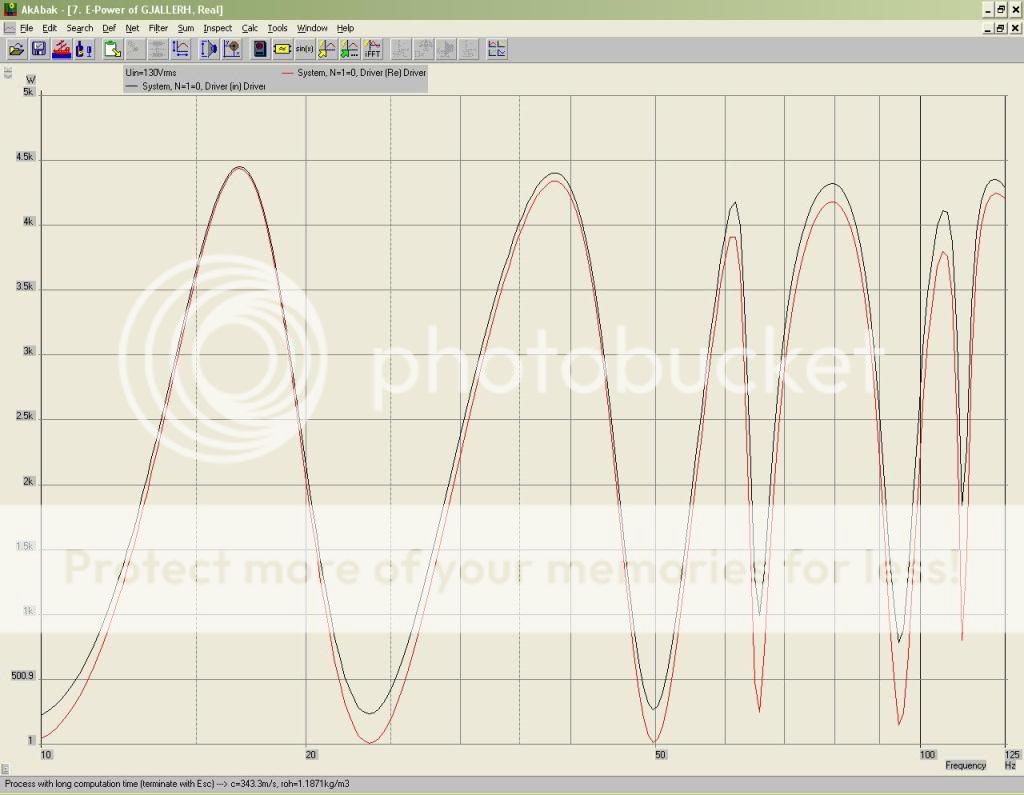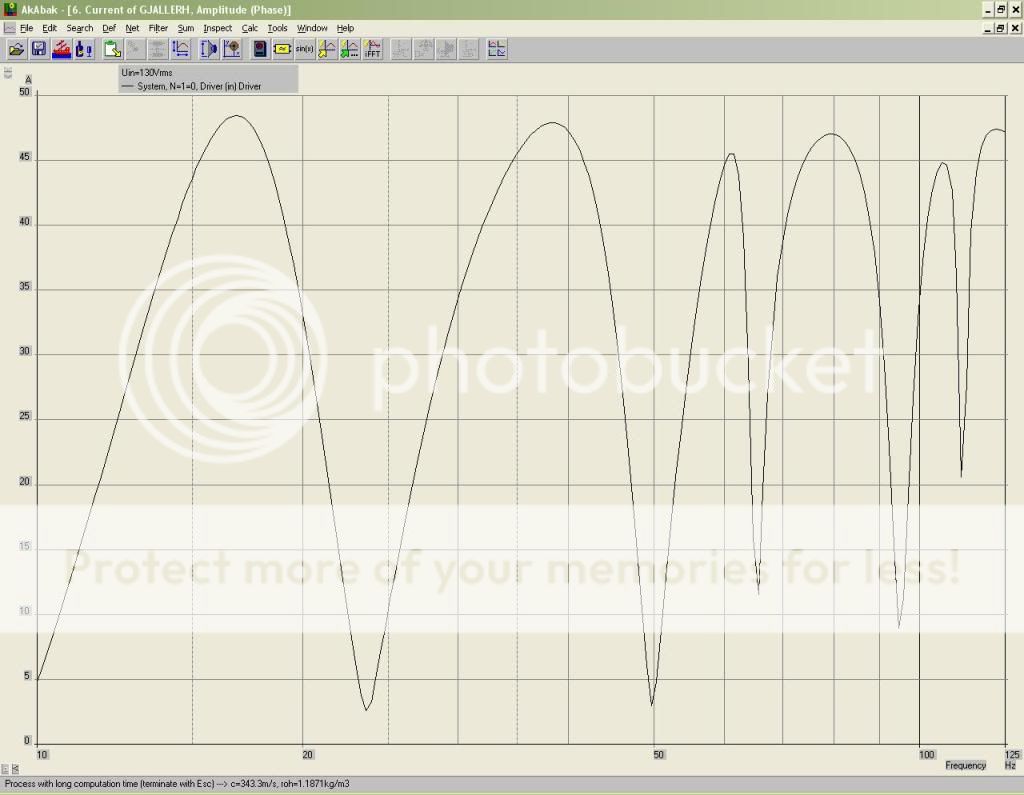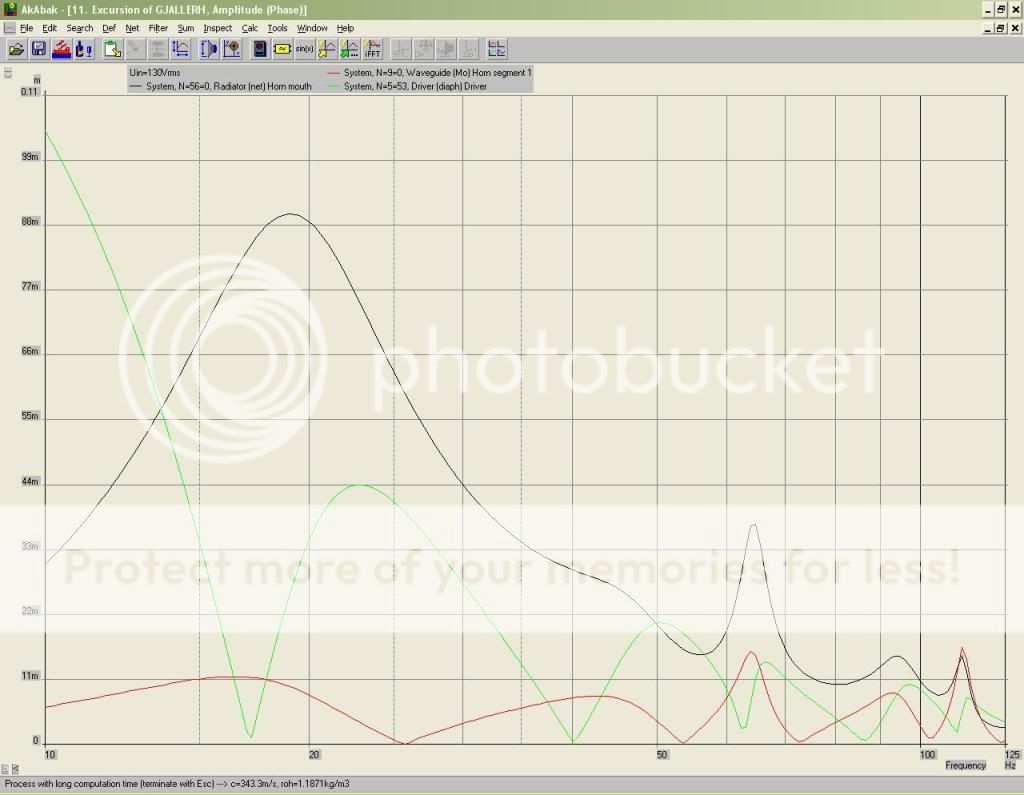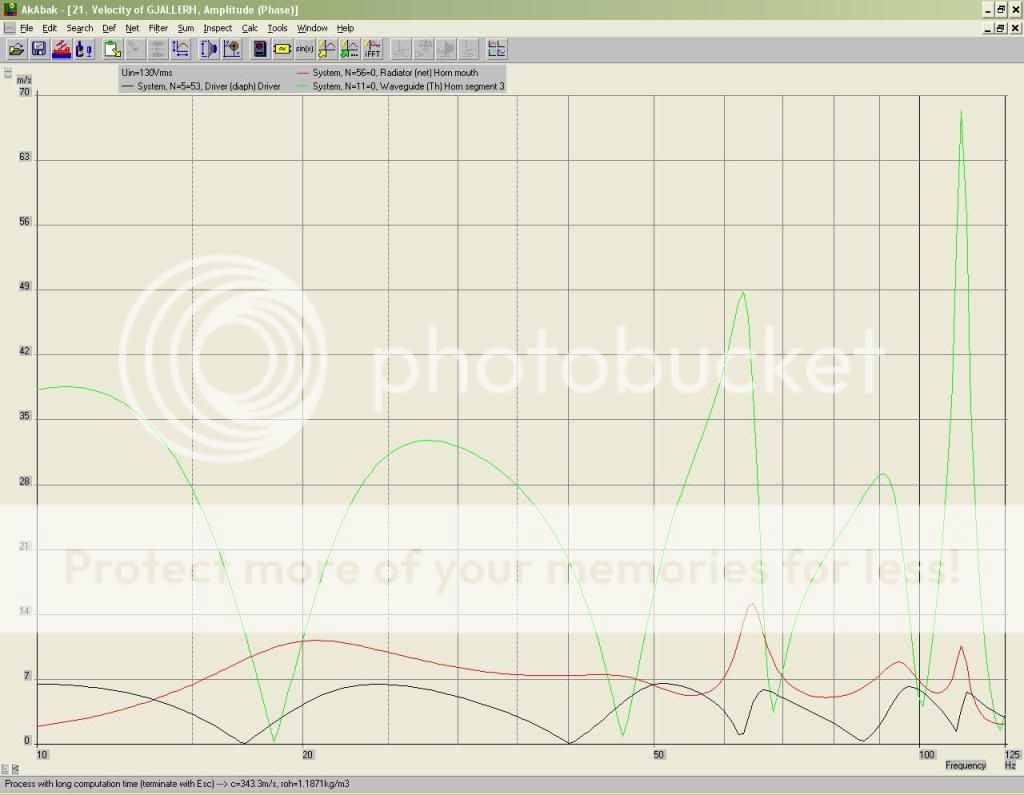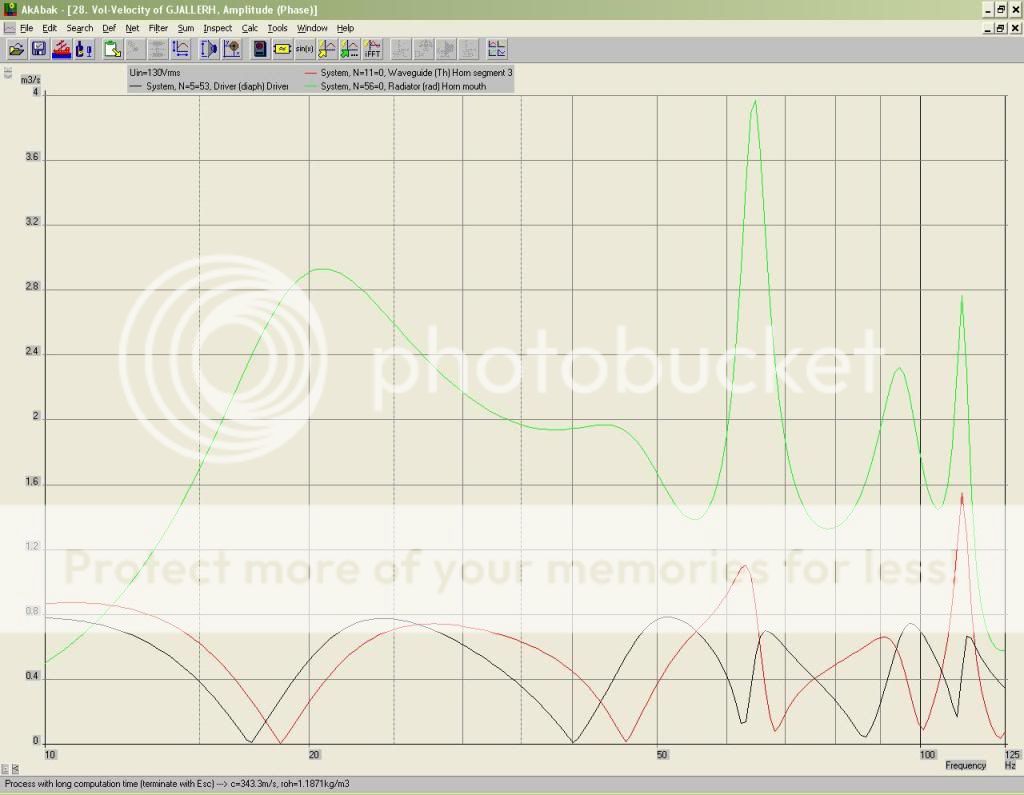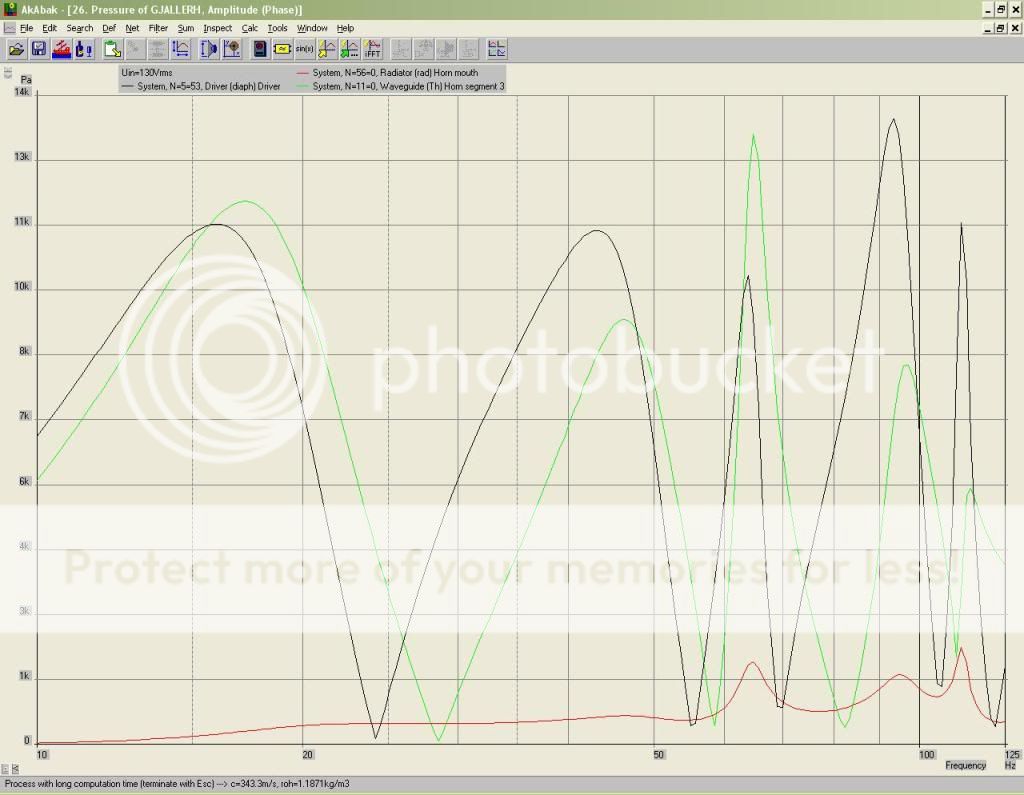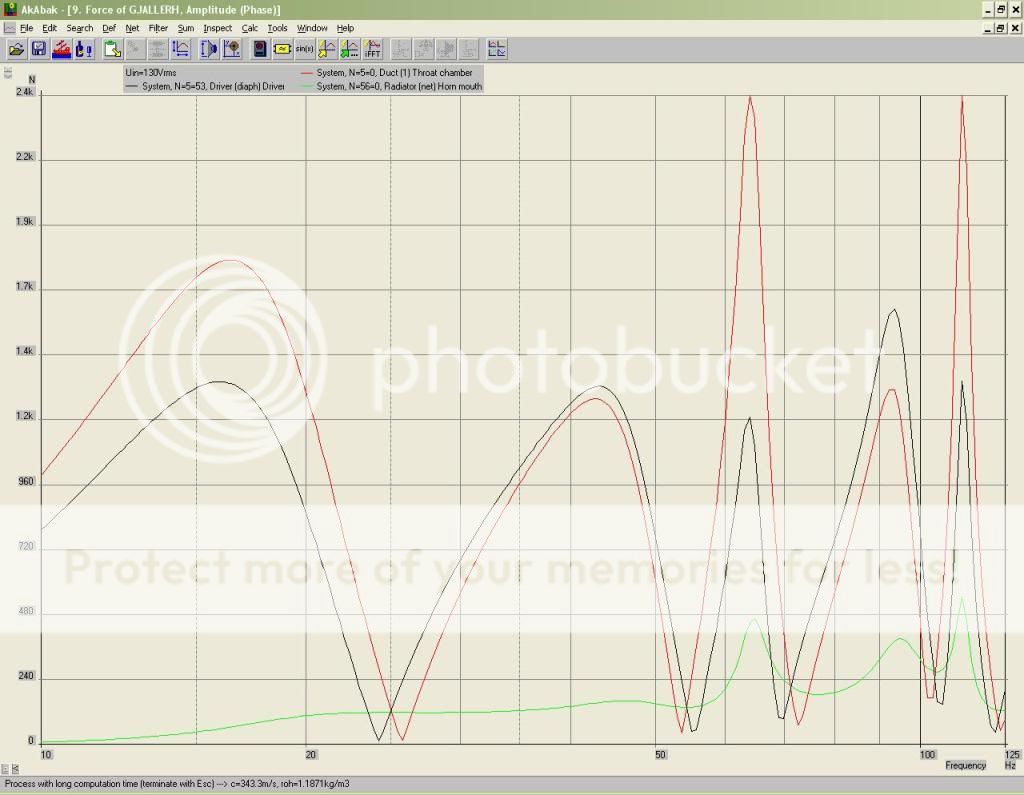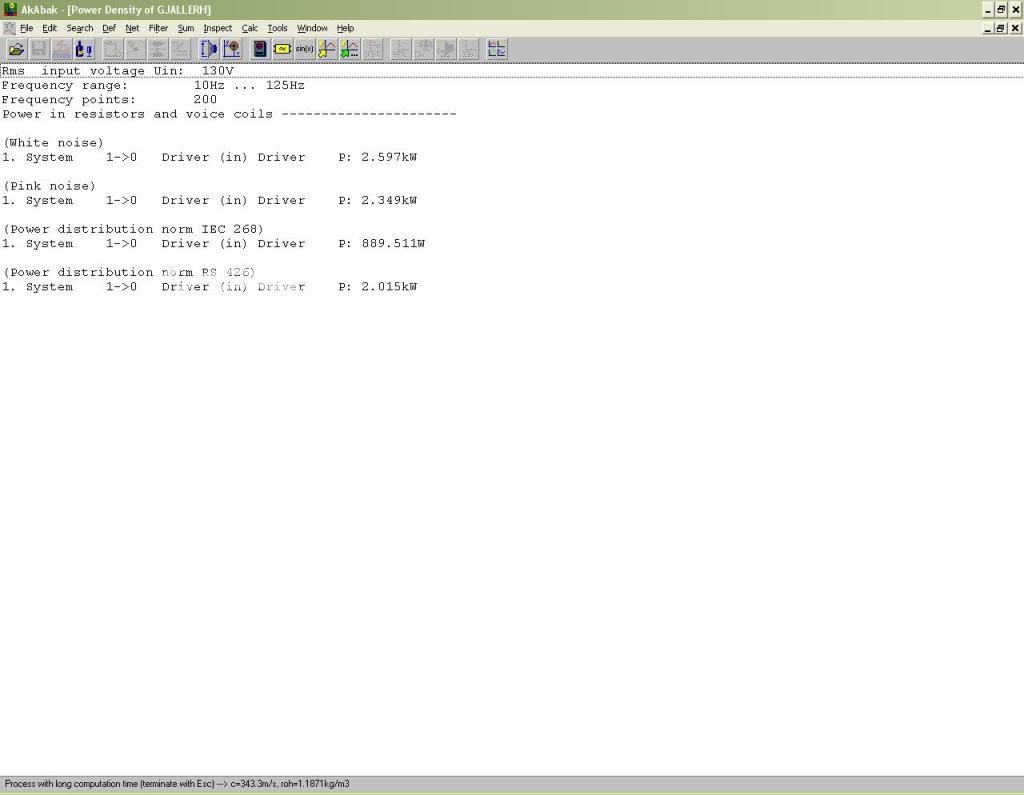Hey Art sorry about the delay. I am chalking the response change up to driver beak in. I know that it wasn't a measurement artifact. Major response features like that are not the sort of thing that I would see do to a change in measurement set-up especially not from a close mic. Moving on...Now I am interested in the response changes I have noted in tapped horns at high power. I have all of the outdoor tests on this one concluded except for the high power impedance measurements which I have yet to do. I expect to see some good information come about from those. Btw the response match after the break in is much closer to the simulation now. The top end has a little less rise to it but all of the peaks and valleys are in the right spots just very slightly lower in frequency. Actually after eq the sound seems similar between the dts10's and these. Eq is a requirement for both IMO. These have about 6db more average headroom over the dts10 though and the distortion performance is better though still exhibiting the craziness once the frequencies get high enough to be in the climb to the 7th harmonic after the dip following the big 5th harmonic. This seems to be a common attribute of tapped horns.
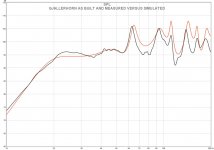

Last edited:
Josh,Hey Art sorry about the delay. I am chalking the response change up to driver beak in. I know that it wasn't a measurement artifact. Major response features like that are not the sort of thing that I would see do to a change in measurement set-up especially not from a close mic.
View attachment 227343
The differences in response around 100Hz didn't look like a "major response feature" to me.
I will repeat the unanswered question: Did you exactly repeat the measurement microphone location, speaker orientation and room position as when you measured the dip?
Add in drive level to the question, since you mention how the harmonic structure changes with level.
Failing all those parameters being identical, I find it easier to believe the change was a measurement artifact rather than due to break in, though either is possible.
I'd like to see a pair of close indoor measurements taken at slightly different distances and orientation that don't exhibit different upper bass frequency response.
Do you have before and after break in impedance measurements ?
Looks like you have the winner for output below 40 Hz, keep up the good work !
Art
They were close mic measurements. As in equidistant with the plane of the mouth. Room effects are entirely swamped out in a measurement like that and not part of the equation. The feature was there whether the drive level was 1 volt or 30. Again sure some minor variance in measurements is to be expected but not sharp high q features like that. Close mic measurements are easily repeatable with minor variation under a wide variety of environmental conditions since the direct sound is orders of magnitude greater than reflected energy. We will have to disagree as to the cause. On to other business. Namely the impedance measurements. I have not had a chance to repeat the impedance sweep or do the high power impedance tests yet. I will as soon as I am able. I did note the drive voltages used for the high power sweeps.
Last edited:
Josh,They were close mic measurements. As in equidistant with the plane of the mouth. Room effects are entirely swamped out in a measurement like that and not part of the equation. The feature was there whether the drive level was 1 volt or 30. Again sure some minor variance in measurements is to be expected but not sharp high q features like that. Close mic measurements are easily repeatable with minor variation under a wide variety of environmental conditions since the direct sound is orders of magnitude greater than reflected energy. .
Room effects may be "entirely" swamped out with close mic measurements but the output of a tapped horn can have plenty of deviations across the mouth and at various "close" distances. That mouth opens into a deep rabbit hole, Alice
Whether the deviations are major or minor is a semantic discussion,(I didn't think the original looked that bad :^) ) but I'll bet you will find upper deviations as much as your before and after measurements simply moving the mic around in the plane of the mouth.
I will also bet that flipping the cabinet on its side, then over will result in another set of deviations, though less than across the mouth.
I would also expect upper FR variations to show up in a two meter ground plane measurement when flipping the cabinet.
Art
I do have a couple of measurements with the cab on its side versus upright and the difference was negligible. I ended up going with the cabs laying on their sides versus upright as originally planned. I just stacked the JBL 4675-C's on top instead of beside. It gives me more room to move the JBL's or aim the horns and I wont have to worry about driver suspension sag long term. After looking at all of the data collected for these I will not run them higher than about 80 or 85hz with a steep low pass and use about 3 bands or peq to chop down the 63hz peak and the 85-100hz area. 15-60hz is where this really does good work.
How are the keystone's doing? Are you running them in a reinforcement or live rig? Did I miss where you released plans for them?
How are the keystone's doing? Are you running them in a reinforcement or live rig? Did I miss where you released plans for them?
Last edited:
Do you play much music where the sub 30 Hz extension makes much difference?I do have a couple of measurements with the cab on its side versus upright and the difference was negligible. I ended up going with the cabs laying on their sides versus upright as originally planned. I just stacked the JBL 4675-C's on top instead of beside. It gives me more room to move the JBL's or aim the horns and I wont have to worry about driver suspension sag long term. After looking at all of the data collected for these I will not run them higher than about 80 or 85hz with a steep low pass and use about 3 bands or peq to chop down the 63hz peak and the 85-100hz area. 15-60hz is where this really does good work.
How are the keystone's doing? Are you running them in a reinforcement or live rig? Did I miss where you released plans for them?
How many volt input were you using for the maximum output graph posted previously?
I have not released any plans for the Keystone sub, but they are simple enough that anyone looking at the line drawing, using a 2.5/1 compression ratio in the middle of the cone, then doing a straight expansion could duplicate it easily using the rest of the information in the posts. Just add bracing !
The Keystones are working fine for live reinforcement (wish I was working more...), as long as they are both wired in the same polarity...
I gave a sound review in the last post of:
http://www.diyaudio.com/forums/subwoofers/185588-keystone-sub-using-18-15-12-inch-speakers.html
Art
Do you play much music where the sub 30 Hz extension makes much difference?
Not much at all. Almost none. Music isn't very demanding unless you just keep turning up the volume knob. Movie sound tracks on the other hand... Cinema performance in a large open space was the idea for this from the get go.
How many volt input were you using for the maximum output graph posted previously?
Art
Initial 90db base sweep was about 1.6volts and the final sweep had the gain increased by 38db so somewhere around 125 to 130 volts give or take a volt or two.

Not much at all. Almost none. Music isn't very demanding unless you just keep turning up the volume knob. Movie sound tracks on the other hand... Cinema performance in a large open space was the idea for this from the get go.
Initial 90db base sweep was about 1.6volts and the final sweep had the gain increased by 38db so somewhere around 125 to 130 volts give or take a volt or two.
Cinema, ah yes, the sound of T-Rex footsteps and battleships crunching.
130 v, around 4225 watts, that would explain the hot magnet !
It still amazes me that we have 4 ohm speakers we can plug directly in to an AC outlet and they will survive.
And amplifiers with enough output to potentially kill us.
Art
1w/1m, 2 volts input.
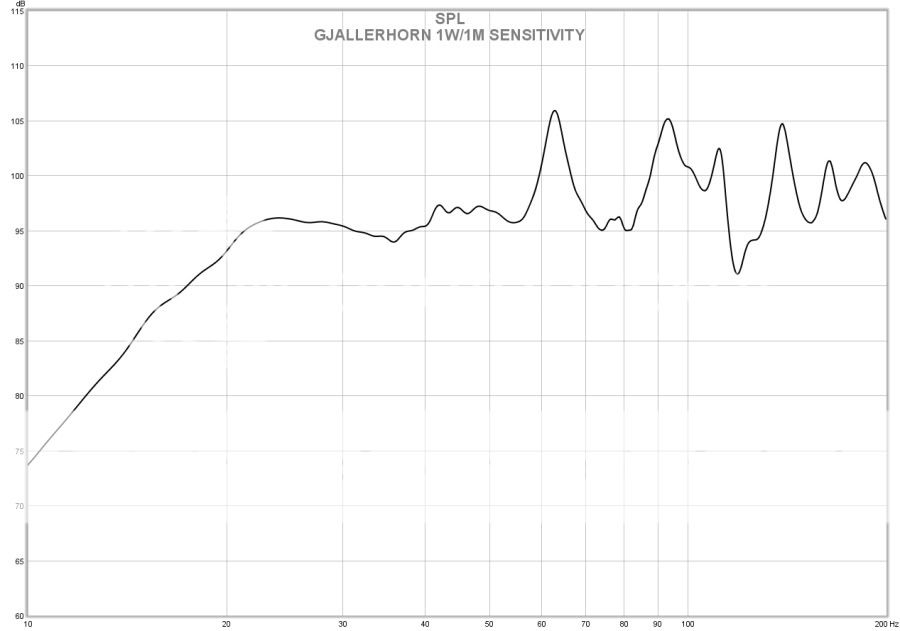
Approximate input voltage for the following nominal levels.
90db 1.63v
95db 2.9v
100db 5.15v
105db 9.16v
110db 16.3v
115db 29v
120db 51.5v
125db 91.6v
128db 130v
Power compression sweeps.

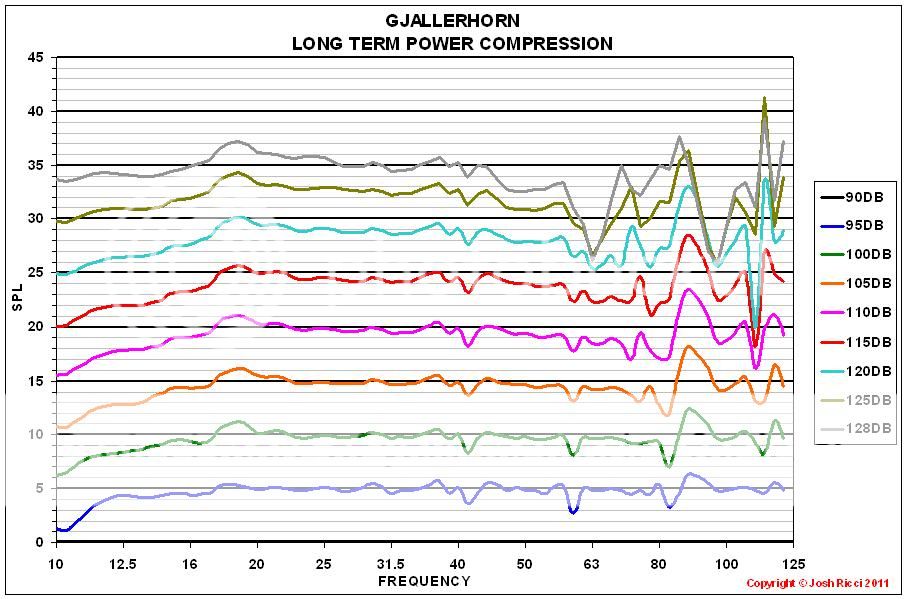
THD and distortion by component measurements.
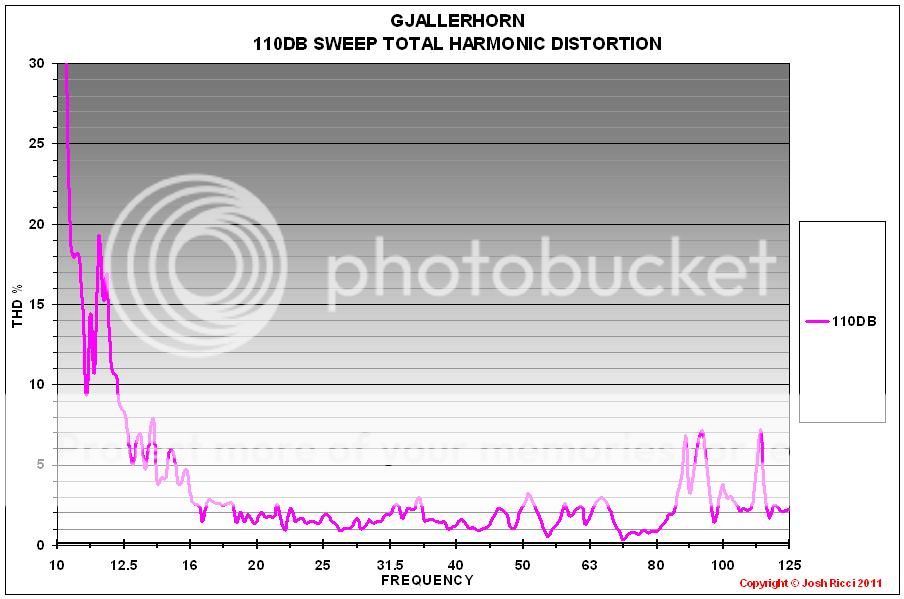
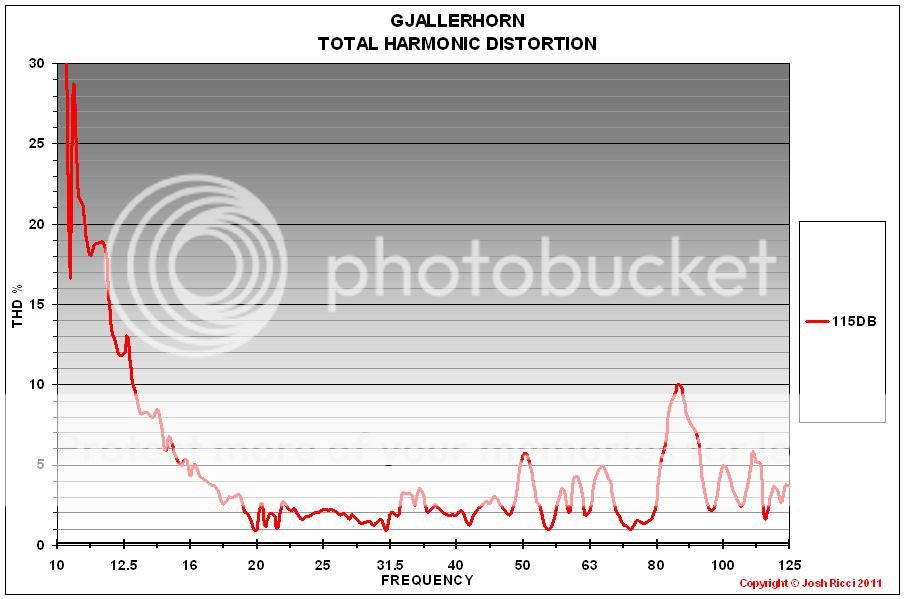

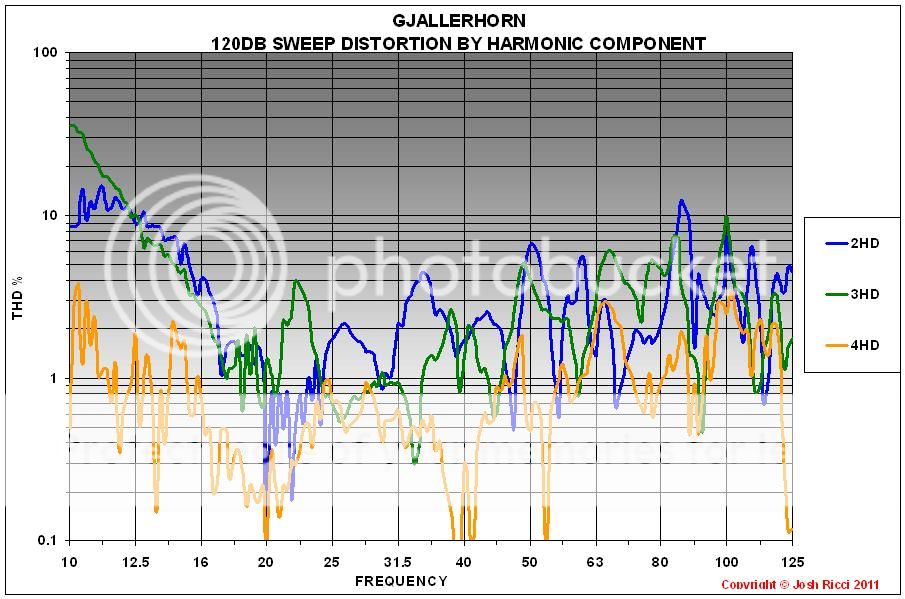
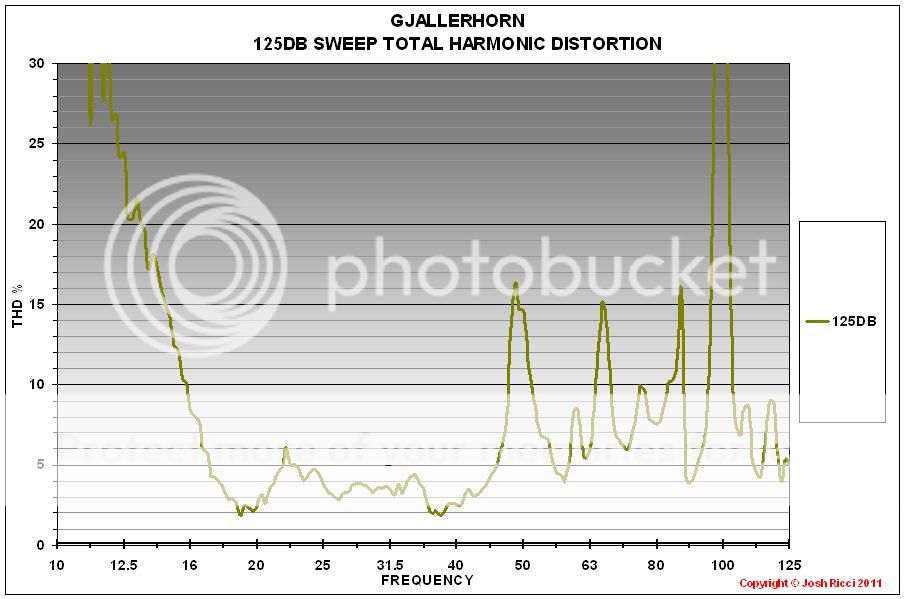

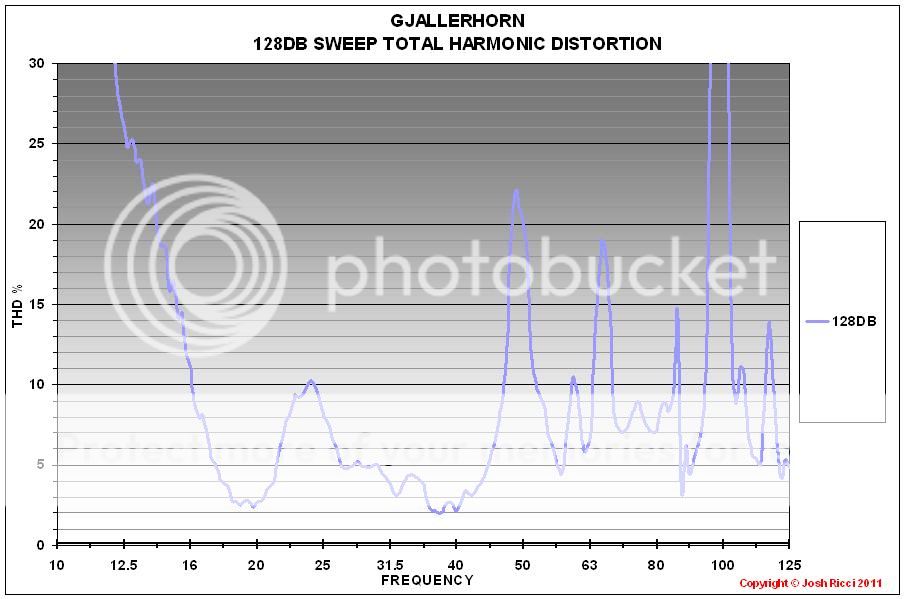
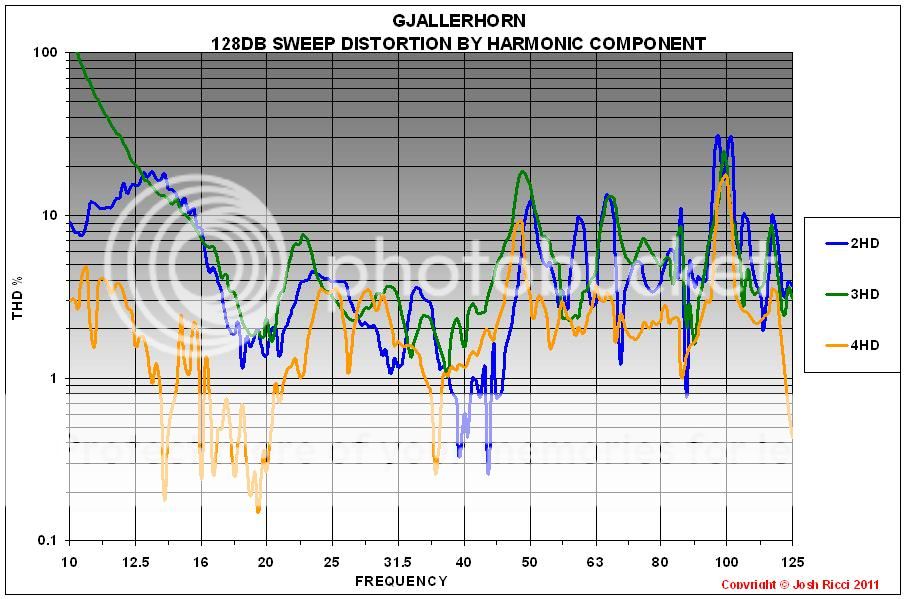
CEA2010 output. Measured at 2 meter, ground plane, rms.
10hz 90.2db
12.5hz 105.2db
16hz 118.3db
20hz 122db
25hz 124.9db
31.5hz 125.8db
40hz 128.4db
50hz 127.2db
63hz 130.2db
80hz 130.9db
100hz 131.1db
125hz 123.6db

Approximate input voltage for the following nominal levels.
90db 1.63v
95db 2.9v
100db 5.15v
105db 9.16v
110db 16.3v
115db 29v
120db 51.5v
125db 91.6v
128db 130v
Power compression sweeps.


THD and distortion by component measurements.








CEA2010 output. Measured at 2 meter, ground plane, rms.
10hz 90.2db
12.5hz 105.2db
16hz 118.3db
20hz 122db
25hz 124.9db
31.5hz 125.8db
40hz 128.4db
50hz 127.2db
63hz 130.2db
80hz 130.9db
100hz 131.1db
125hz 123.6db
Thanks man. Yes these are not playing around. A pair is "adequate" inside a building.  . 2 or even 4 of these would be great fun for an Imax or Omnimax theater install.
. 2 or even 4 of these would be great fun for an Imax or Omnimax theater install.
I think there are some trends apparent here if you consider the pressure, imp, velocity, current and acceleration data from Akabak in context with the actual compression and distortion measurements. The distortion performance I am pretty happy with really. The dramatic spikes up seen at high power seem to be inherent to TH's when driven hard. The DTS10 both in stock form and with alternate drivers exhibited similar spike in distortion. This cab is ridiculously clean from 15-45hz considering the power applied and the output. It gets rough above there but again given the levels used, I consider that it stays well under 15% THD from 15- 95hz even at the 130v level except for 2 up spikes at 50 and about 67hz to be great. The biggest spike in distortion near 100hz is also where I note that at the highest input levels the cab develops a buzz. Were I to build another pair I would beef up the internal bracing more. I plan to cross at 85hz or lower anyway.
Note that in the power compression test there is what appears to be an upper ceiling to how loud this sub will go at some frequencies no matter the increase in input power. There is a very large amount of compression of the 63hz responce peak and also the 85-110hz area where the sub also exhibits peaks in its response. Again this same type of compression behavior was noted with the DTS-10. A follow up test with EQ applied is planned. I have a feeling it will have some good effects on the distortion and high power compression performance in addition to giving the sub a smoother more linear response. For example the sub plateau's out at 63hz and ends up exhibiting nearly 12db of compression at the 130v input level. However looking at the basic response at the lowest 90db or 1.63v input level 63hz is boosted almost 11db relative to the surrounding frequencies to begin with. The same story is apparent at 85-110hz where the response is boosted up by 5 to 10db and again the compression and distortion performance is worst in this area. The output has already almost plateau'd at these frequency ranges by the 120db, 51.5v sweep. Further input does little more than add to the distortion. Once the response is EQ'd to be flatter at these frequencies by cutting some 5-12db of output, the compression performance, distortion and power demands on the amplifier should all improve quite a bit while the maximum output should be affected barely at all, plus the decay and response will be smoother. That's the theory anyway. Should be a win/win all around.
If you are running TH's I would consider EQing the major spikes in response down a must for better performance of the cabinet.
I think there are some trends apparent here if you consider the pressure, imp, velocity, current and acceleration data from Akabak in context with the actual compression and distortion measurements. The distortion performance I am pretty happy with really. The dramatic spikes up seen at high power seem to be inherent to TH's when driven hard. The DTS10 both in stock form and with alternate drivers exhibited similar spike in distortion. This cab is ridiculously clean from 15-45hz considering the power applied and the output. It gets rough above there but again given the levels used, I consider that it stays well under 15% THD from 15- 95hz even at the 130v level except for 2 up spikes at 50 and about 67hz to be great. The biggest spike in distortion near 100hz is also where I note that at the highest input levels the cab develops a buzz. Were I to build another pair I would beef up the internal bracing more. I plan to cross at 85hz or lower anyway.
Note that in the power compression test there is what appears to be an upper ceiling to how loud this sub will go at some frequencies no matter the increase in input power. There is a very large amount of compression of the 63hz responce peak and also the 85-110hz area where the sub also exhibits peaks in its response. Again this same type of compression behavior was noted with the DTS-10. A follow up test with EQ applied is planned. I have a feeling it will have some good effects on the distortion and high power compression performance in addition to giving the sub a smoother more linear response. For example the sub plateau's out at 63hz and ends up exhibiting nearly 12db of compression at the 130v input level. However looking at the basic response at the lowest 90db or 1.63v input level 63hz is boosted almost 11db relative to the surrounding frequencies to begin with. The same story is apparent at 85-110hz where the response is boosted up by 5 to 10db and again the compression and distortion performance is worst in this area. The output has already almost plateau'd at these frequency ranges by the 120db, 51.5v sweep. Further input does little more than add to the distortion. Once the response is EQ'd to be flatter at these frequencies by cutting some 5-12db of output, the compression performance, distortion and power demands on the amplifier should all improve quite a bit while the maximum output should be affected barely at all, plus the decay and response will be smoother. That's the theory anyway. Should be a win/win all around.
If you are running TH's I would consider EQing the major spikes in response down a must for better performance of the cabinet.
Last edited:
Josh,Thanks man. Yes these are not playing around. A pair is "adequate" inside a building.. 2 or even 4 of these would be great fun for an Imax or Omnimax theater install.
The biggest spike in distortion near 100hz is also where I note that at the highest input levels the cab develops a buzz. Were I to build another pair I would beef up the internal bracing more. I plan to cross at 85hz or lower anyway.
Note that in the power compression test there is what appears to be an upper ceiling to how loud this sub will go at some frequencies no matter the increase in input power. A follow up test with EQ applied is planned. I have a feeling it will have some good effects on the distortion and high power compression performance in addition to giving the sub a smoother more linear response. That's the theory anyway. Should be a win/win all around.
If you are running TH's I would consider EQing the major spikes in response down a must for better performance of the cabinet.
IIRC you used Baltic Birch, you could probably drill a hole using a drill bit extender through the multiple fold area and screw a threaded rod (or two or three) to stiffen that area up. May not be worth the work if you are crossing below where the cabinet buzzes, but it might help smooth response too.
Like you, I have noticed my tapped horns have frequency specific power compression with high power sine wave testing, but the specific frequency compression was not present with high powered pink noise.
When you do the EQ test, it would be interesting to see if you also note a difference between pink noise and swept sine regarding power compression.
What gauge and length wire did you use in your outdoor tests ?
Art Welter
3 conductors of an 8/4 out to the amplifier and 2 conductors of a 10/3 soj cable out to the cabinet. Voltage was measured at the speaker cabinet connection.
Threaded rod huh? Let me think on that.
I have used threaded rod directly in to Baltic Birch for some goofy application, so it seems like that might be a retroactive fix. With regular ply, the cabinet vibrations might tear out the wood around a threaded rod, but BB has enough plys and glue where that should not be a problem on a rod of 1/2" or larger.
If you alternately tip the cabinet up on the front and back while the speaker is playing, I'm sure the screw sawdust would blow on out.
My question about the speaker cable was regarding damping factor at the speaker, a long speaker cord would not allow the amp to exert as much control on the speaker, which could possibly account for some power compression at certain frequencies.
threaded rod
Hi there: Use of threaded rod without locking nuts on both sides of the internal structure may lead to additional buzzing, after some use. Should you remove the rods later, you will be faced with plugging holes between internal sections of the TH. Such holes would retune the horn at best and ruin it at the worst. ... regards, Michael
3 conductors of an 8/4 out to the amplifier and 2 conductors of a 10/3 soj cable out to the cabinet. Voltage was measured at the speaker cabinet connection.Threaded rod huh? Let me think on that.
Hi there: Use of threaded rod without locking nuts on both sides of the internal structure may lead to additional buzzing, after some use. Should you remove the rods later, you will be faced with plugging holes between internal sections of the TH. Such holes would retune the horn at best and ruin it at the worst. ... regards, Michael
Yes...I will likely not try the threaded rod for these reasons. I worry about drilling 25" into the cabinet and being able to get the rod threaded in. Sealing issues and the possibility that it may not improve things also make me hesitant. It would be a lot of work too try it.
I can add a brace in the throat area easily, so I may try that.
I can add a brace in the throat area easily, so I may try that.
- Status
- This old topic is closed. If you want to reopen this topic, contact a moderator using the "Report Post" button.
- Home
- Loudspeakers
- Subwoofers
- Gjallerhorn

